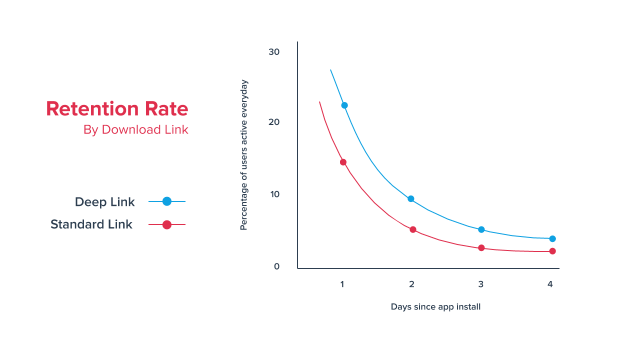There’s something about apps that makes people want to close the deal. Compared to mobile web, in-app conversion rates are 3x higher than mobile web, and in-app average order value (AOV) is 140% higher.* But to reap these rewards, you need lots of installs and lots of active users. And according to research, you need deep links.
What are Deep Links?
What are deep links? They are the links that lead users directly from your partners to your app in the location tied to the original link context. A recent study* found that users who were dropped off on the app homepage were significantly less engaged than users who were deep linked in the app. Users who were deep linked were more likely to become daily active users of the app, probably because they enjoyed a better, more relevant user experience. That increase in daily active users often translates to higher lifetime value (LTV) users and a greater revenue potential for your business (and partners).

Why is in-app deep linking so tricky?
Deep linking to your apps improves customer experience, engagement, LTV, conversions, and thus revenue for you and your referring partners. But there is also a lot of back-end complexity that has to be overcome to create a smooth and traceable journey from a partner link to conversion and payout. For example:
- Mobile users navigate not just within a browser but between web browsers and mobile applications
- Mobile devices must identify which app (if it is installed) is the relevant one to open
- There must be a way to contain conditional information (i.e., what to do if the app is not installed)
- There needs to be a way to retain information between:
- The initial link click
- The visit to the app store
- The installation of the app
- The subsequent launch of the app (even if the user doesn’t open it immediately)
Universal Links and App Links, solutions launched by Google and Apple, partially address deep linking complexity, but only if the consumer already has your app installed. Universal Links and App Links are basically URLs that point to both a web page and a location inside an app. When the link is tapped, the OS checks whether the app is installed and either deep links to the app or opens the equivalent URL in the phone’s browser. But:
- They offer no simple solution for what’s known as deferred deep linking — when a user without an app installed gets redirected to the app store, and then the app remembers what state to open once the app is launched.
- They make traditional click tracking impossible for attribution purposes, since they don’t work with redirects.
TrueLink™ closes the deep linking loop
To resolve these issues for businesses in the partnership economy, Impact leverages a combination of TrueLink™ technology, which simplifies the complexities of deep linking, and our page-load API, which provides click tracking for attribution purposes.
With these solutions, the user journey can look like this:
- A user who does not have your app installed sees a great offer on your partner’s mobile website.
- When they click on it, you sweeten the deal to encourage the user to install the app (i.e., “Hey, take an additional 5% off your purchase if you install the app!”).
- The user installs and opens the app, where they land right on the location containing the offer they saw in the first place PLUS they get an additional 5% off for installing your app, making a purchase very likely.
- Your mobile partners don’t have to do anything extra to get this all working, they receive the same tracking URL they’ve always had, and they are compensated accurately.
In-app deep linking doesn’t have to be complicated, and it’s a powerful way to drive more revenue from your partnerships and your app investment.
Learn more about deep linking in our eBook, Exploring the Deep Linking Frontier, or talking with a growth specialist at sales@impact.com.
*Sources: Criteo Global Commerce Review, Branch’s The Agile Approach to Building an Effective Mobile Growth Stack




